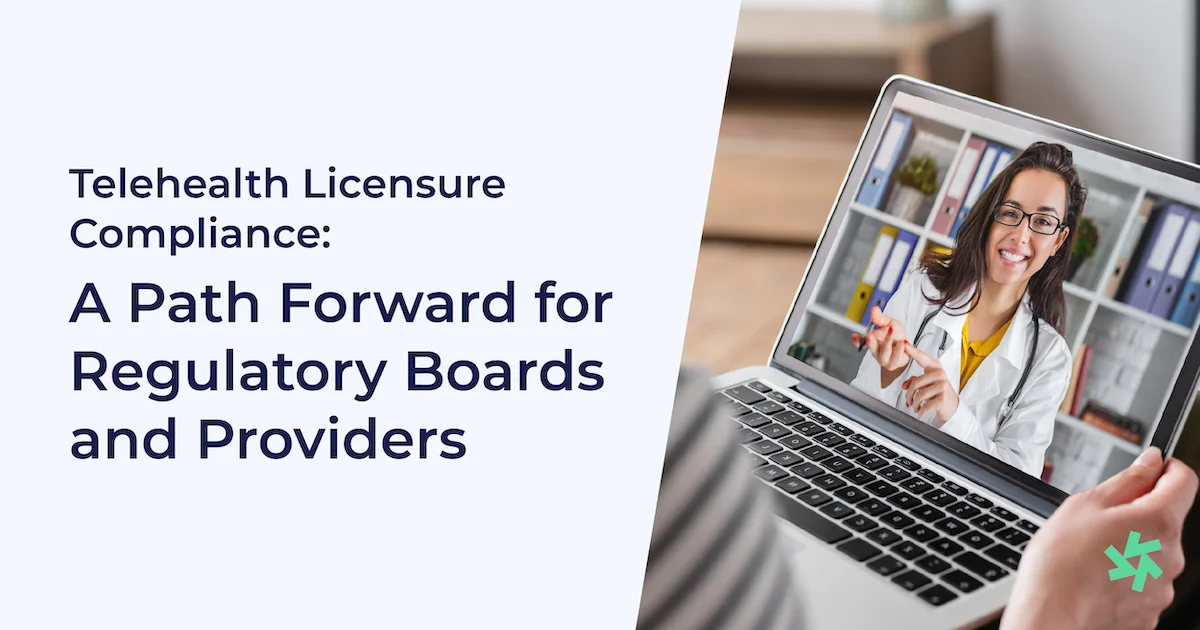
Telehealth is no longer an alternative – it’s a core solution
Virtual care has exploded in the post-COVID era and transformed how healthcare is delivered, breaking down geographic barriers and significantly improving access, particularly for underserved and rural communities. This shift has been accompanied by a rise in interstate licensure compacts, universal licensure laws, and reciprocity initiatives designed to support a more flexible, cross-border healthcare workforce. However, this digital convenience brings a new kind of complexity for the regulatory boards and telehealth organizations tasked with ensuring caregivers stay safe, qualified, and compliant.
When Care Goes Virtual, Licensing Gets Complicated
The rise of telehealth has redefined the healthcare landscape. While licensure compacts like the Interstate Medical Licensure Compact (IMLC), Nurse Licensure Compact (NLC), and Psychology Interjurisdictional Compact (PSYPACT) are expanding mobility and making it easier for providers to practice across state lines, the core responsibility of protecting the public and upholding licensure standards still lies squarely with licensing bodies. For example, whether a compact model is based on mutual recognition or an expedited licensure pathway, one fundamental principle remains unchanged: licensing boards must consistently ensure that professionals are competent to practice in our communities.
For patients, this means better access to timely care, particularly in areas like mental health and chronic disease management. For licensing bodies, licensed professionals, and telehealth organizations, this shift has introduced new layers of operational and compliance complexity that can’t be ignored. Each state maintains its own continuing education (CE) requirements, licensure laws, and enforcement procedures, meaning licensing bodies must juggle an increasing number of out-of-state applicants, renewals, and verifications—often with limited resources and outdated tools.
Caught in the regulatory tangle: Challenges for boards, multistate professionals, and telehealth organizations
The challenges extend to both sides of the regulatory coin:
- For Licensing Bodies: Manual processes slow things down, inconsistencies creep in, and internal systems are strained. Verifying CE, managing audits, and processing applications across multiple states manually can be a significant burden, potentially delaying licensure and renewal workflows.
- For Licensed Professionals: Those practicing in multiple states must navigate a patchwork of CE rules, renewal timelines, and audit procedures, which can feel overwhelming. They didn’t enter the profession to chase paperwork; they entered to care for people. They need systems that support their ability to stay licensed, compliant, and focused on patients.
Additionally, telehealth organizations must verify licenses, certifications, registrations, and sanctions, while also reviewing for and monitoring exclusions on an ongoing basis. Using outdated, manual processes for these important steps creates an administrative burden and can delay hiring and onboarding.
Technology as the catalyst: streamlining compliance and operations
Modern, integrated platforms like CE Broker by Propelus and Propelus Data Solutions are proving essential. By automating CE tracking, simplifying audit processes, and delivering consistent, real-time compliance data, CE Broker helps both regulators and professionals navigate the complexity of multistate licensure in a telehealth-driven world. The result is a more agile, transparent, and efficient regulatory environment that strengthens both public protection and professional support.
Additionally, Propelus Data Solutions can help telehealth organizations address the complexities of verifying licenses, certifications, exclusions, and other data for healthcare professionals across multiple states, thereby serving their patient populations effectively. Our primary source-verified data can be integrated into existing systems and confirms that telehealth practitioners are compliant and in good standing to work.
Outdated, manual systems don’t scale; they delay licensure, complicate renewals, and create barriers to transparency for licensing bodies, while creating inefficiencies and slowing hiring and onboarding for telehealth organizations. If licensing bodies and telehealth organizations want to meet today’s heightened expectations and stay ahead of evolving compliance requirements, they need solutions that modernize processes without compromising standards.
Simplifying multi‑state compliance in a borderless era
Disconnected systems don’t just frustrate users – they fragment workflows. With telehealth adoption surging, licensing bodies must evolve from siloed systems to unified platforms that handle licensure, CE tracking, audits, and renewals in one streamlined environment.
That’s where platforms like CE Broker and Propelus Data Solutions shine. By centralizing key compliance tasks, CE Broker helps licensing bodies:
- Accelerate licensure and renewals
- Standardize audits across jurisdictions
- Boost transparency and organization performance
- Reduce administrative burden
- Protect the public with greater confidence
Propelus Data Solutions also helps telehealth organizations:
- Check licenses, certifications, exclusions, and other data for healthcare professionals across multiple states
- Mitigate risk by avoiding non-compliance violations and fines
- Automate processes and streamline administrative tasks, saving time and resources
- Accelerate hiring and onboarding
Efficiency and consistency are no longer optional; they are vital to supporting both regulatory responsibilities and the evolving needs of telehealth organizations.
The wrap up
The healthcare landscape is shifting. To keep pace, licensing bodies and telehealth organizations must lead with innovation, not paperwork. By embracing modern, digital-first solutions, licensing bodies and telehealth organizations can support providers, strengthen oversight, and ensure care remains safe and accessible – no matter where it’s delivered.